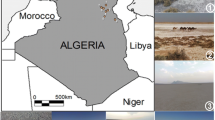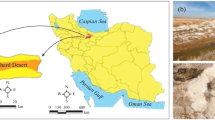Abstract
A novel haloalkaliphilic bacterium designated as strain BNMIITR was isolated from a soil sample collected from Sambhar lake, Rajasthan, in northern India. Colonies of the isolated strain were dark orange and comprised Gram-negative bacilli; there was a slight pleomorphism towards the stationary phase of growth. Experiments revealed that the isolate can grow in the range of 2–5 M NaCl, pH 6–11 and 18–55 °C, with optimum growth observed at 3 M NaCl, pH 8–8.5 and 45 °C. No growth was observed in culture medium without NaCl. The isolate showed no requirement for magnesium sulphate heptahydrate (MgSO4 .7H2O) for growth. Major cellular fatty acids were C 14:0, C 15:0 iso, C 15:0 anteiso, C 16:0, C 17:0 iso, C 17:0 anteiso and C 20:2 w6, 9c. The result of 16S rRNA gene sequence analysis showed 98 % sequence similarity with Halobiforma lacisalsi and Hbf. haloterrestris. Halobiforma sp. strain BNMIITR showed resistance towards several antibiotics and produced an extracellular alkaline protease. The crude enzyme was found to be active in broad range of alkaline pH and temperature (30–80 °C).






Similar content being viewed by others
References
Amoozegar MA, Malekzadeh F, Malik KA (2003) Production of amylase by newly isolated moderate halophile Halobacillus sp. Strain MA-2. J Microbiol Methods 52:353–359
Amoozegar MA, Schumann P, Hajighasemi M, Fatemi AZ (2008) Salinivibrio proteolyticus sp. nov. a moderately halophilic and proteolytic species from a hypersaline lake in Iran. Int J Syst Evol Microbiol 58:1159–1163
Asker D, Ohta Y (1999) Production of canthaxanthin by extremely halophilic bacteria. J Biosci Bioeng 88:617–621
Banerjee UC, Sani RK, Azmi W, Soni R (1999) Thermostable alkaline protease from Bacillus brevis and its characterization as a laundry detergent additive. Proc Biochem 35:213–219
Bodaker I, Sharon I, Suzuki MT et al (2010) Comparative community genomics in the Dead Sea: an increasingly extreme environment. J ISME 4:399–407
Buckner JS, Hagen MM, Nelson DR (1999) The composition of the cuticular lipids from nymphs and exuviae of the Silverleaf Whitefly, Bemisia argentifolii. Comp Biochem Physiol 124B(2):201–207
Cuadros Orellanaa S, Pohlschro DM, Durrant LR (2006) Isolation and characterization of halophilic archaea able to grow in aromatic compounds. Int Biodeterior Biodegrad 57:151–154
Dussault HP (1955) An improved technique for staining red halophilic bacteria. J Bacteriol 70(4):484
Elevi R, Assa P, Birbir M, Ogan A, Oren A (2004) Characterization of extremely halophilc archaea isolated from the Ayvalik salterns, Turkey. World J Microbiol Biotechnol 20:719–725
Gibbons NE (1974) Family V. Halobacteriaceae fam. nov. In: Buchanan RE, Gibbons NE (eds) Bergey’s manual of determinative bacteriology, 8th edn. Williams & Wilkins, Baltimore, pp 269–273
Grant WD, Kamekura M, McGenity TJ and Ventosa A (2001) Class III. Halobacteria Class. nov. In: Boone DR, Castenholz RW (eds) Bergey’s manual of systematic bacteriology, 2nd edn, vol. 1. Springer, New York Berlin Heidelberg, pp 294–301
Haddar A, Agrebi R, Bougatef A, Hmidet N et al (2009) Two detergent stable alkaline serine-proteases from Bacillus mojavensis A21: purification, characterization and potential application as a laundry detergent additive. Bioresour Technol 100:3366–3373
Hezayen FF, Rehm BHA, Tindall BJ, Steinbus Chel A (2001) Transfer of Natrialba asiatica B1T to Natrialba taiwanensis sp. nov. and description of Natrialba aegyptiaca sp. nov. a novel extremely halophilic, aerobic, non-pigmented member of the archaea from Egypt that produces extracellular poly (glutamic acid). Int J Syst Evol Microbiol 51:1133–1142
Hezayen FF, Tindall BJ, Steinbuchel A, Rehm BHA (2002) Characterization of a novel halophilic archaeon, Halobiforma haloterrestris gen. nov., sp. nov. and transfer of Natronobacterium nitratireducens to Halobiforma nitratireducens comb. nov. Int J Syst Evol Microbiol 52:2271–2280
Karan R, Khare SK (2010) Purification and characterization of a solvent-stable protease from Geomicrobium sp. EMB2. Environ Technol 31(10):1061–1072
Hamid Reza, Karbalaei H, Amoozegar MA et al (2009) Production, optimization and purification of a novel extracellular protease from the moderately halophilic bacterium Halobacillus karajensis. J Ind Microbiol Biotechnol 36:21–27
Karbalaei-Heidari HR, Amoozegar MA, Hajighasemi M, Ziaee, Ventosa A (2009) Production, optimization and purification of a novel extracellular protease from the moderately halophilic bacterium Halobacillus karajensis. J Ind Microbiol Biotechnol 36:21–27
Kasana RC, Salwan R, Dhar H et al (2008) A rapid and easy method for the detection of microbial cellulase on agar plate using Gram’s iodine. Curr Microbiol 57:503–507
Kunitz M (1947) Crystalline soybean trypsin inhibitor. II General properties. J Gen Physiol 30:291–310
Margesin R, Schinner F (2001) Potential of halotolerant and halophilic microorganisms for biotechnology. Extremophiles 5:73–83
Namwong S, Hiraga K, Takada K, Tsunemi M et al (2006) A halophilic serine proteinase from Halobacillus sp. SR5–3 isolated from fish sauce: purification and characterization. Biosci Biotechnol Biochem 70:1395–1401
Narasingarao P, Podell S, Ugalde JA et al (2012) De novo metagenomic assembly reveals abundant novel major lineage of Archaea in hypersaline microbial communities. J ISME 6:81–93
Onishi H, Mori T, Takeuchi S et al (1983) Halophilic nuclease of a moderately halophilic Bacillus sp. Production purification and characteristics. Appl Environ Microbiol 45:24–30
Oren A (2002) Diversity of halophilic microorganisms: environments, phylogeny, physiology, and applications. J Ind Microbiol Biotechnol 28:56–63
Oren A (2012) Taxonomy of the family Halobacteriaceae: a paradigm for changing concepts in prokaryote systematics. Int J Syst Evol Microbiol 62:263–271
Oren A, Ventosa A, Grant WD (1997) Proposed minimal standards for description of new taxa in the order Halobacteriales. Int J Syst Bacteriol 47:233–238
Pugh EL, Kates M (1994) Acylation of proteins of the archaebacteria Halobacterium cutirubrum and Methanobacterium thermoautotrophicum. Biochem Biophys Acta 1196:38–44
Sabet S, Diallo L, Hays L, Jung W, Dillon JG (2009) Characterization of halophiles isolated from solar salterns in Baja California, Mexico. Extremophiles 13:643–656
Samad MYA, Razak CAN, Salleh AB, Zinwan Yunus WM et al (1989) A plate assay for primary screening of lipase activity. J Microbiol Methods 9:51–56
Setyorini E, Takenaka S, Murakami S, Aoki K (2006) Purification and characterization of two novel halotolerant extracellular proteases from Bacillus subtilis strain FP-133. Biosci Biotechnol Biochem 70:433–440
Sharma AK, Walsh AD, Bapteste E, Valera FR et al (2007) Evolution of rhodopsin ion pumps in haloarchaea. BMC Evol Biol 7:79
Shivanand P, Jayaraman G (2009) Production of extracellular protease from halotolerant bacterium, Bacillus aquimaris strain VITP4 isolated from Kumta coast. Proc Biochem 44(10):1088–1094
Sinsuwan S, Rodtong S, Yongsawatdigul J (2010) A NaCl-stable serine proteinase from Virgibacillus sp. SK33 isolated from Thai fish sauce. Food Chem 119:573–579
Soares MMCN, Silva R, Gomes E (1999) Screening of bacterial strains for pectinolytic activity: characterization of the polygalacturonase produced by Bacillus sp. Rev Microbiol 30:299–303
Upasani V, Desai S (1990) Sambhar salt lake chemical composition of the brines and studies on haloalkaliphilic archaebacteria. Arch Microbiol 154:589–593
Xin H, Itoh T, Zhou P, Suzuki K, Nakase T (2001) Natronobacterium nitratireducens sp. nov., A haloalkaliphilic archaeon isolated from a soda lake in China. Int J Syst Evol Microbiol 51:1825–1829
Xu WX, Wu M, Zhou PJ, Liu SJ (2005) Halobiforma lacisalsi sp. nov., isolated a salt lake in China. Int J Syst Evol Microbiol 55:1949–1952
Acknowledgments
The authors gratefully acknowledge the financial support from the Department of Biotechnology IIT Roorkee and Govt. of India for providing research fellowship.
Author information
Authors and Affiliations
Corresponding author
Electronic supplementary material
Below is the link to the electronic supplementary material.
ESM 1
(ONE 43 kb)
Supplementary Table 1
(DOC 27 kb)
Supplementary Table 2
(DOC 57 kb)
Supplementary Fig. 1
Sensitivity of strain BNMIITR to antimicrobial agents. Antibiotic agents present (clock wise) are 1a: Oxacillin (Ox), vancomycin (Va), ampicillin (Amp), cephalothin (CEP), chloramphenicol (C), clindamycin (CD), erythromycin (E) and gentamicin (GEN) 1b: cefuroxime (CXM), penicillin-G (P), tetracycline (TE), co-trimoxazole (COT), cloxacillin (COX), cefradine (CH), erythromycin (E), lincomycin (L) (GIF 142 kb)
Supplementary Fig. 2
Absorption spectra of pigment from isolate Halobiforma sp. strain BNMIITR extracted in methanol/acetone (1:1 v/v). (GIF 61 kb)
Supplementary Fig. 3
Fatty acid analysis by Gas chromatography (GIF 108 kb)
Supplementary Fig. 4
Protease production by Halobiforma sp. strain BNMIITR on skimmed milk agar plate. (GIF 189 kb)
Rights and permissions
About this article
Cite this article
Gupta, M., Aggarwal, S., Navani, N.K. et al. Isolation and characterization of a protease-producing novel haloalkaliphilic bacterium Halobiforma sp. strain BNMIITR from Sambhar lake in Rajasthan, India. Ann Microbiol 65, 677–686 (2015). https://doi.org/10.1007/s13213-014-0906-z
Received:
Accepted:
Published:
Issue Date:
DOI: https://doi.org/10.1007/s13213-014-0906-z




